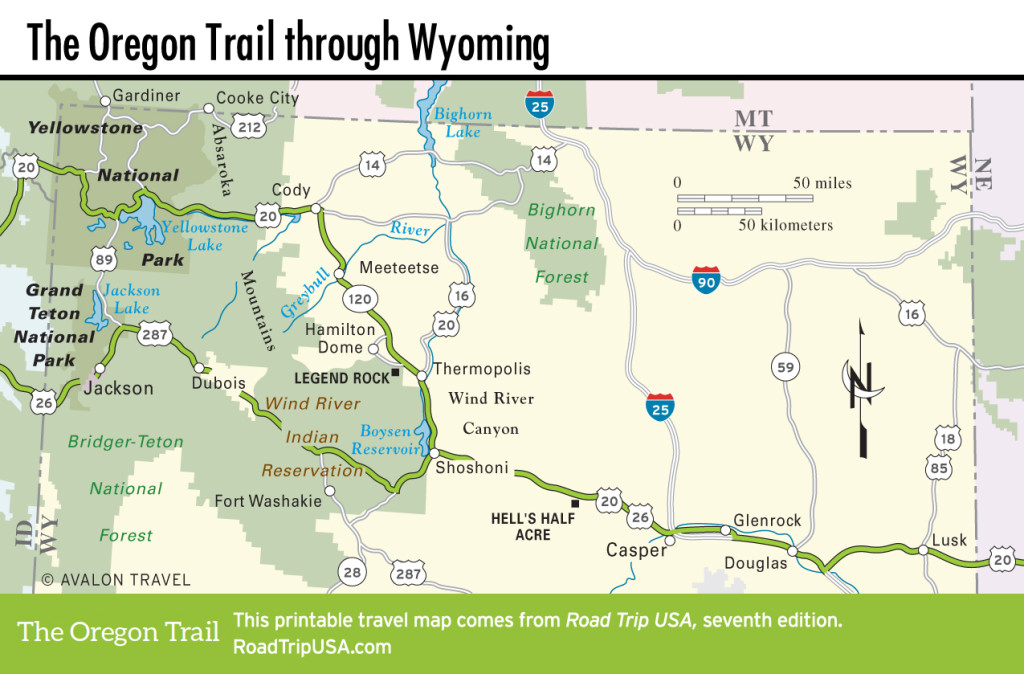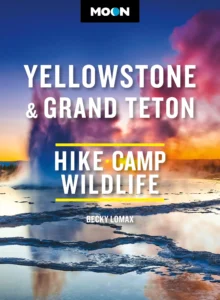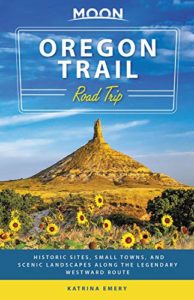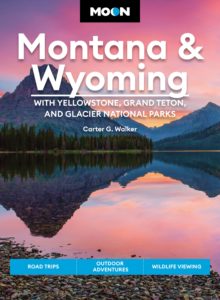Glenrock to Guernsey
Glenrock
Midway between Casper and Douglas along the south bank of the North Platte River, Glenrock (pop. 2,554) was a vital rest stop and supply station on the Oregon and other emigrant trails. Several downtown buildings have endured since its heyday, when Glenrock was known as Deer Creek Station and some 20,000 migrants came through each year, many of them camping overnight at the “rock in the glen” on the west side of town, where a sandstone boulder still holds the names of passing pioneers. Nowadays, Glenrock is known for its massive 800-megawatt coal-fired power plant, one of the largest in the country; a pair of wind farms intended to generate 100 megawatts of electricity are under construction nearby.
Between Casper and Glenrock, US-26 winds along the river, but between Glenrock and Douglas the old road has been replaced by the I-25 freeway. Midway to Douglas, 14 mi (22.5 km) east of Glenrock, turn off I-25 onto Natural Bridge Road and drive 5 mi (8 km) south of the freeway to visit one of Wyoming’s unsung beauty spots, Ayres Natural Bridge, which arches 30 ft (9 m) above peaceful La Prele Creek, next to a small campground in a pleasant county park.
Douglas
Situated far enough off I-25 to retain its Wild West cowboy character, the enjoyable town of Douglas (pop. 6,273) was founded in 1886 across the river from Fort Fetterman, which for the previous 25 years had protected traffic on the old Oregon and Bozeman Trails along the North Platte River. The setting of Owen Wister’s genre-inventing Western novel The Virginian and, more recently, birthplace of that other Wild West icon, the jackalope, Douglas is a quietly picturesque small town with a wild history, and a great place to break your long-distance road trip.
The Wyoming State Fairgrounds, along the river at the west end of Center Street, host a livestock-frenzied fair at the end of August. The fairgrounds also feature the year-round Wyoming Pioneer Museum (307/358-9288, Mon.-Fri. Oct.-May, Mon.-Sat. June-Sept., free), packed full of artifacts from the late 1800s—everything from rifles and a roulette table to fossils and farm implements. It also houses a Sioux-style hide tepee made for the movie Dances with Wolves. The wilder side of Douglas history is perhaps most vividly apparent in tombstones in the cemetery on the east edge of town at the end of Pine Street, where legendary cattle rustler George Pike is interred beneath an impressive marker that reads, in part:
Underneath this stone in eternal rest sleeps the wildest one of the wayward west.
Lusk
A cattle-ranching and farming center, Lusk (pop. 1,541) is the largest town in the least-populated county in the country’s least-populated state. It also boasts the only traffic light on US-20 between Douglas, Wyoming, and Chadron, Nebraska. And if those claims to fame don’t make you want to stop, the Stagecoach Museum (322 S. Main St., 307/334-3444, Mon.-Fri., by appointment Sat.-Sun., $2) definitely will, if only to see the sole authentic 1880s Cheyenne-Deadwood Stagecoach—the one Doris Day sang about in Calamity Jane. (The only other stagecoach from this legendary route is now in the Smithsonian.) Behind the museum building is another frontier icon—a one-room schoolhouse—and along US-20 at the east edge of town, a plaque points out a redwood water tower dating from 1886, when steam locomotives still chugged across the plains.
Lusk also has a good range of motels, including the Covered Wagon Motel (730 S. Main St., 307/334-2836, $100 and up).
Guernsey
A worthwhile detour from Douglas via I-25 and US-26 takes you 40-plus mi (64 km) south to the town of Guernsey (pop. 1,148) on the North Platte River, where you can visit two of the most evocative Oregon Trail historic sites. The Oregon Trail passed through along the south bank of the river and the well-signed Guernsey State Park. A mile (1.6 km) south of town via Wyoming Avenue you’ll find the best surviving set of Oregon Trail wagon ruts, cut shoulder-deep in the soft sandstone. Nearby is a small obelisk marking the grave of an unfortunate pioneer, and 3 mi (4.8 km) to the southeast along the same road, Register Cliff is carved with the names of over a thousand pioneers and explorers, many dating back to 1840-1860, the heyday of the trail. Fort Laramie National Historic Site, another frontier landmark, is 15 mi (24 km) east of Guernsey via US-26.

















